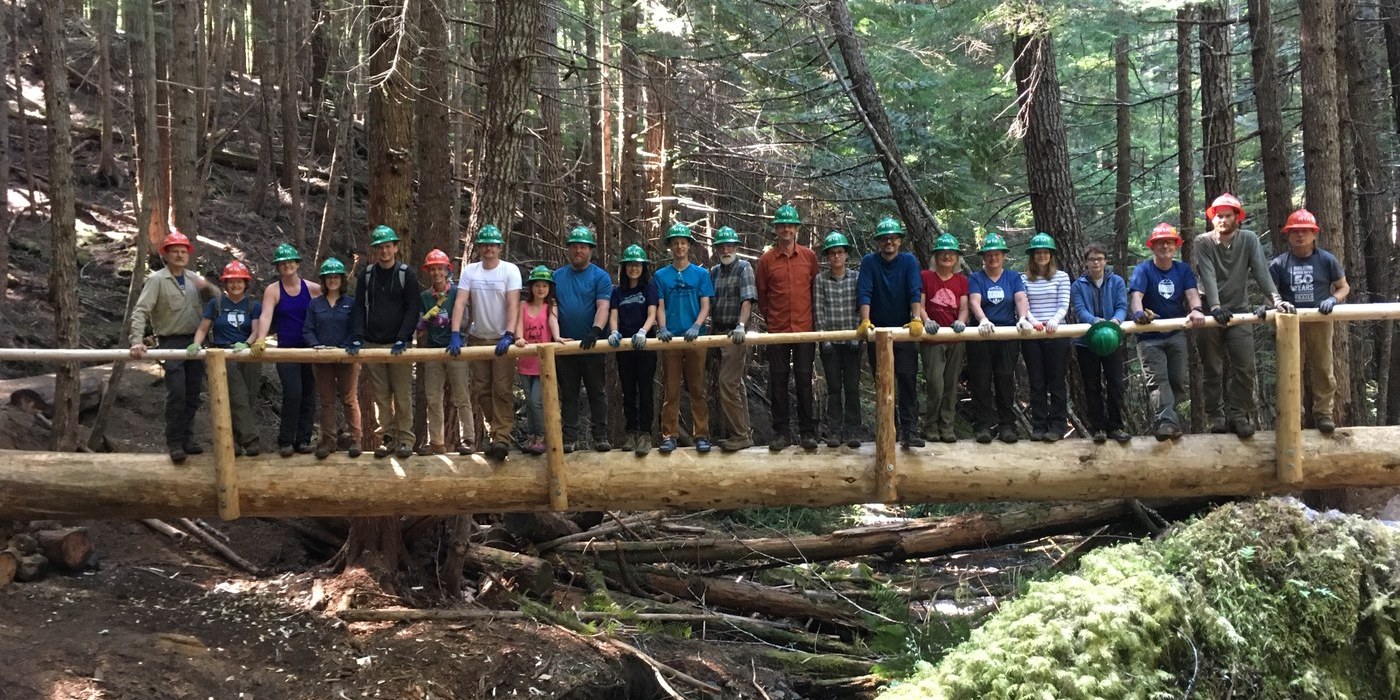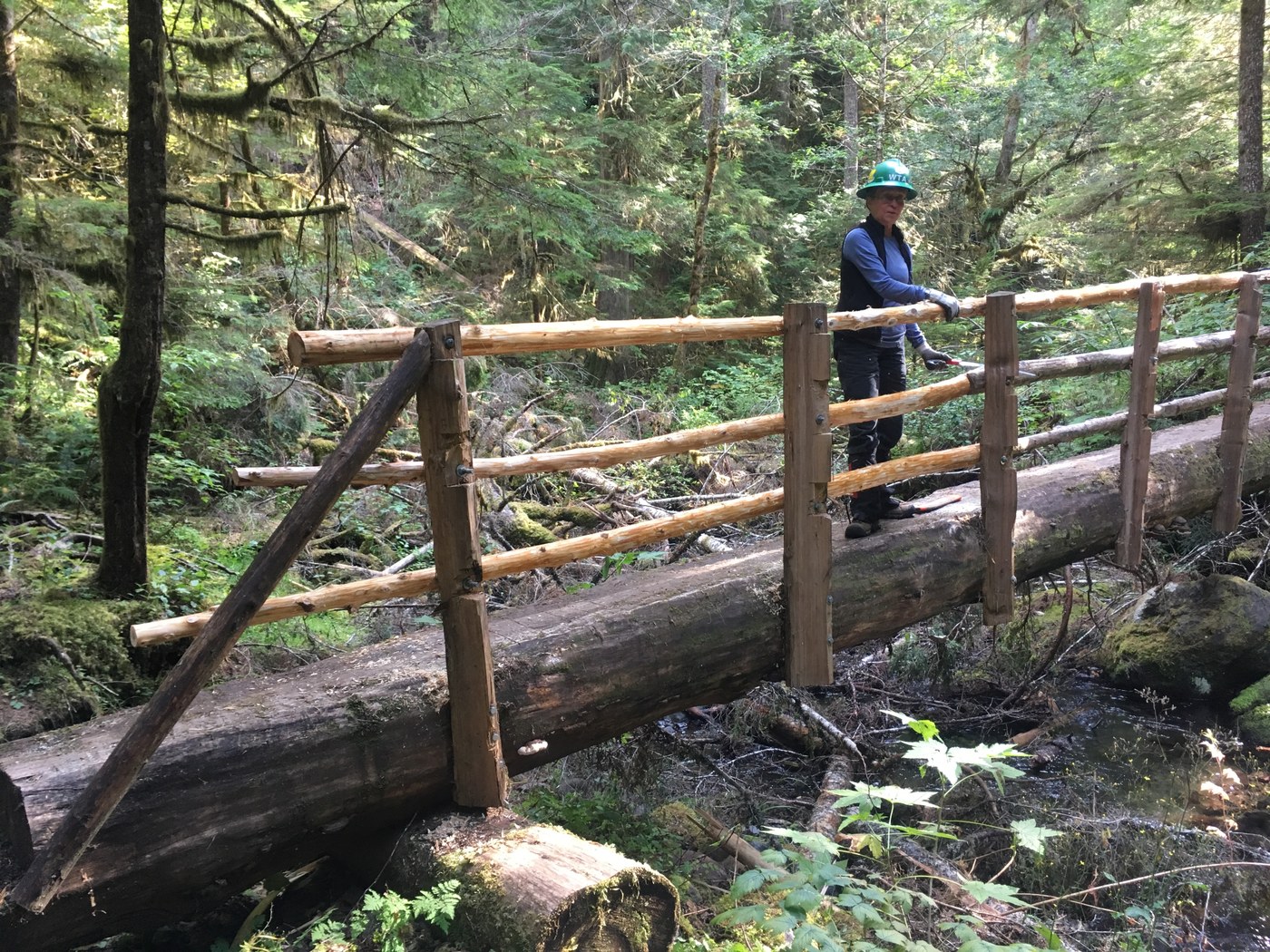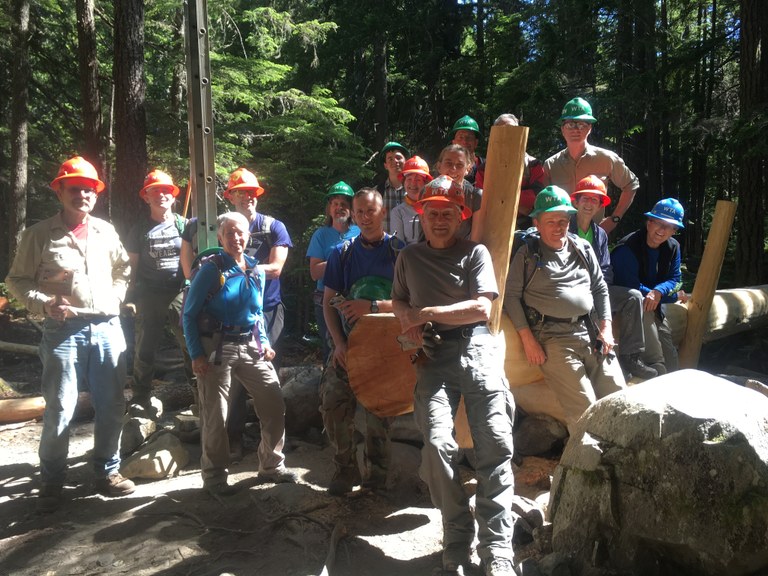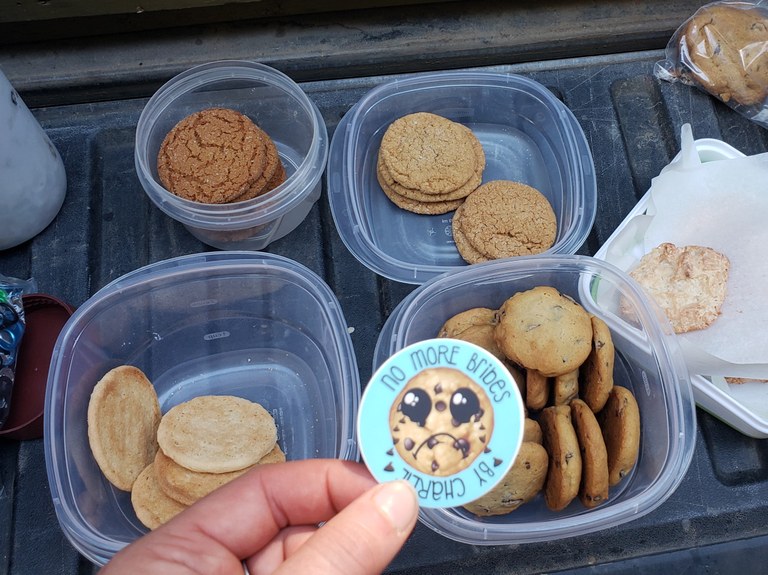 Washington Trails
Association
Washington Trails
Association
Trails for everyone, forever
For 12 years, she has been slinging dirt, building bridges and installing rock walls on the Olympic Peninsula. Her can-do energy, flexibility and resourcefulness has shaped a generation of volunteers. | By Anna Roth

The summer of 2024 is crew leader Charlie Romine's last season with WTA. After 12 years working seasonally with WTA, she's heading to Gainesville, Fla., to be with her dad full time and to possibly volunteer with a veterans organization.
Before she goes, it's worth reflecting on how she's shaped not only multiple trails on the Olympic Peninsula, but the community of volunteers who love working with her. (We're pretty sure it's not just because of the cookies she ends all her work parties with, but they probably help.)
On WTA crews, almost everyone has a nickname, whether they pick it or acquire it. Charlie's is "Can Do". It's appropriate, reflecting her flexibility, resourcefulness and ability to go with what comes her way. It's also a reference back to her prior career, in the Navy SeaBees (formally known as the Navy Construction Battalion) The SeaBees do complicated construction projects in all conditions, and their ability to deliver led to their motto "Can Do".
Charlie brought both a love of construction work and that SeaBee can-do attitude to the Olympic Peninsula in 2009, when she was transferred up to Washington from Port Hueneme, California. She ended her 30-year career here 2 years later, as a Masterchief (E9), and the Assistant Officer in Charge (AOIC) at Construction and Battalion Maintenance Unit 303 Detachment Bangor.

Charlie had done volunteer trail maintenance while stationed in California. She'd worked on the Ojai Ranger District of the Los Padres National Forest with ranger Heidi Anderson. So she knew a bit about trail work. And she knew that a great way to learn about where to hike or backpack in a new area is to link up with groups who work on trails.
So before she moved, she looked at the Olympic National Forest website to find ways to volunteer. She found three possible options.
"The site listed the Mountaineers, BCH [Back Country Horsemen of Washington] and WTA as the organizations to volunteer through ... I didn't want to buy a horse to volunteer with the BCH, so I decided to check out this organization called "Washington Trails Association'."
Charlie arrived in Washington on April 24, 2009. Four days later she was on her first work party.
The work parties were more structured than in California, where volunteers worked directly with the Forest Service staff. But Charlie enjoyed the community of people she met, and continued to come back. She was learning a lot especially from Field Programs Manager Alan Carter Mortimer, and was building on those trail skills she'd started with in California.
With her 29 years of leadership experience in the SeaBees and an expanding set of trail skills, she was soon filling in as a volunteer crew leader if WTA's staff crew leader Richard J. was on other projects. So when Richard left, Alan approached Charlie with a job offer. But she didn't want it, initially.
"My first reaction was to tell [Alan] that I didn't want a full time job because I had just retired from 30 years in the Seabees.

Charlie's construction work with the SeaBees was soon empowering volunteers to do complicated construction projects all across the Peninsula. Photos courtesy Charlie Romine.
But WTA needed a crew leader and we liked Charlie's style. After some back and forth, Charlie, Alan and Olympic National Forest reached an agreement that worked for everyone: Charlie would work two days a week leading volunteer crews and spend one day a week scouting the trails.
Charlie was a snowbird, living between Washington and Florida so she could spend time with her parents in the winter, so the agreement hinged on her working seasonally.
So began what would become a 12-year cycle. Around April, Charlie heads up to Washington, and is based out of Gig Harbor until late September or early October doing trail work on the Peninsula.
In that first year, she was surprised to learn how cyclical trail work is.
"The first year I thought that I had "fixed" all of the trail issues and would not be needed the next year. I did receive the job offer the next year and quickly learned that Mother Nature changes trail conditions a little or a lot, so I knew then that I had job security."
These days, those conditions change a lot more than a little. With more intense storms and wildfires happening even on the Peninsula, every summer sees a new bridge that needs to be replaced or a lot of logs to remove. Charlie was going to be busy for as long as she'd stick around.


The Mount Townsend Bridge before (top) and after volunteer attention, led by Charlie. Photo courtesy Charlie Romine.
But in addition to enjoying trail work, Charlie enjoyed working with volunteers and teaching them trail skills. She was doing a lot of mentoring; identifying interested, passionate crew members and training them to become assistant crew leaders or crew leaders.
In the Seabees she had learned the importance of training your replacement, regardless of your rank. WTA has a tiered system for trail crews. Crew leader (or blue hats) are in charge of the work party. They're supported by Assistant Crew Leaders (orange hats), who each get a team of volunteers (green hats) to help make the projects for the day.
 Assistant Crew Leaders (orange hats) can work on subprojects during work parties, extending WTA's capacity to complete work. Photo courtesy Charlie Romine.
Assistant Crew Leaders (orange hats) can work on subprojects during work parties, extending WTA's capacity to complete work. Photo courtesy Charlie Romine.The tiers reminded Charlie of the leadership structure she'd learned in the Seabees, and she applied the same training and leadership principles when she became a crew leader for WTA.
"I was used to being able to assign tasks/projects to the different crew leaders in the Seabees, and I didn't see any reason I couldn't do the same with WTA."
This approach helped engage and retain more people. With more autonomy, and more ongoing trail education, volunteers came back more regularly. Charlie was building a base of people she—and WTA—would be able to rely on for years, who in turn would inspire and train other future volunteers.

Charlie (in blue hat) at Crew Leader College 2024 with Richard Pedersen (left) instructing a class on the components for a rigging setup. Photo by Anna Roth.
Many of our current volunteer blue hats point to Charlie's influence as a reason they leveled up to crew leaders. Al Mashburn, who leads Backcountry Response Teams and some day work parties, says it only took a few days working with Charlie to get him hooked on trail work. And Dawn Rorvik took just a few years to move from new volunteer to crew leader:
"Charlie has identified and mentored a generation of crew leaders in the Olympics. I am not exaggerating when I say that she has shaped me into the crew leader I am. She is very generous with her knowledge. And shares it with green, orange, and blue hats alike. One of her mottoes is, 'Knowledge shared is power.' ... Even though she has done an excellent job of recruiting and mentoring orange and blue hats here, her retirement will leave a Charlie-sized hole in the Olympics."
As ACLs got more confident taking volunteers to work on more technically complicated projects, Charlie was able to get more done on each work party.
"The volunteers leadership allowed me to spread out the crews to tackle work up and down the trail instead of keeping everyone at or near the same project ... we have been able to coordinate for more work to be done or a project completed, such as when Dawn led a Rapid Response crew on Notch Pass 3 to finish a small crib wall project last month."
WTA's work party motto is to Be safe, have fun, and get work done. By training her "replacements", Charlie was doing all three, especially because so many trails on the Peninsula require major construction, Charlie's forté.

Charlie (far right in blue hat) with a large crew of volunteers towards the end of a day of building the Royal Creek bridge. Photo courtesy Charlie Romine.

Volunteers are all smiles on Charlie's work parties, no matter the task. Photos courtesy Charlie Romine.
Charlie's excitement at what volunteers accomplish is evident in her trip reports from finished worksites and her summary reports that are sent to the crew. She thanks everyone who made the work possible, including hikers, land managers, and volunteers. The skill building and the public appreciation keep people coming but of course, there's also the cookies.
WTA always offers treats at the end of each work party: chips, cookies, pop, water. Charlie realized just how much sodium is in the packaged goodies, and that homemade cookies have less sodium than store bought. So on her first work party as a crew leader, she brought a batch of homemade. What was at first an experiment has bloomed into a standby on Charlie's work parties.
"I ... bake lots of different cookies, cookie bars and brownies to see what they tasted like and did they survive the ride down a pothole-ridden road or not. (Meringue cookies did NOT. Chocolate chip, ginger, oatmeal raisin, snickerdoodle, flourless peanut butter and other cookies DO."
Now its not uncommon for Charlie to bring a wide selection, curated for different dietary restrictions and crew member preferences. On a recent work party I attended, there were no less than five options: ginger snaps, soft and chewy ginger, vanilla wafers, an allergen-free macaroon, and chocolate chip!
The cookies are so well known (and expected) that you might spot a sticker on a hard had featuring a cookie, and boasting: "I was bribed by Charlie."
Charlie's can-do charm and belief in others translates beyond each work party. She's also very enthusiastic about mentoring people. She uses a gentle but encouraging approach, which she developed from some advice she got early on in her career at WTA.
 Charlie's mentorship paved the way for volunteer crew leaders like Dawn Rorvik (above right) to lead on project. Photo courtesy Charlie Romine.
Charlie's mentorship paved the way for volunteer crew leaders like Dawn Rorvik (above right) to lead on project. Photo courtesy Charlie Romine. "When I see someone with potential, I pull them off to the side and tell them to think about stepping up to become an ACL when they're ready. A few ACLs I have pulled off to the side to consider becoming crew leaders."
These tactics are now in use by WTA's trail maintenance program as part of our mentorship of volunteers. In fact, Charlie is a big reason for our trail maintenance program's mentorship program and robust leadership pipeline today, as WTA's Volunteer Coordinator Andrea Waite can attest:
"These tactics are now in use by WTA's trail maintenance program as part of our training of volunteers. In fact, Charlie is a big reason for our robust leadership pipeline today. We mirrored her relationship-forward mentorship style to help build the new ACL [assistant crew leader] Pathway. She has built a community, and through doing that has naturally enabled leaders to rise up in that community."
To what end is all this teaching and leadership working? It's to increase capacity and empower people. Building a community of people you can rely on helps WTA make a bigger dent in the backlog of trail maintenance, and having a community of people makes it easy to come on work parties again and again. And it helps when that community is a fun, welcoming and encouraging one.
Join an Olympic Peninsula work party and you'll notice the stickers. Small, white and circular, printed with 'Semper Gumby', in a bendy, bright forest green font reminiscent of Gumby himself. Many of the regular volunteers have them: They appear on hat brims, inside of hard hats, on laptops and phone cases and plastic totes full of gear and tools in the backs of cars and trucks.
Charlie explained it means "always flexible" to me as she handed me one of these stickers on a warm September afternoon. The crew was munching on a selection of cookies and reflecting on a full day's work.

We savored those cookies, since this year was the last one we'd be enjoying homemade bribes from Charlie. Photo by Anna Roth.
Our team had been lugging cedar logs downhill (thankfully) about a half mile to a project site, then de-barking the logs for winter projects. Another crew had installed a gorgeous turnpike, then come uphill to "watch us debark those cedar logs." When we noticed two of the logs had heart-rot, it was no big deal. Dawn, our team leader, had scouted several other possible cedars that were much closer to the worksite she could get later in the year. It was the 'Semper Gumby' philosophy in action.
As Charlie heads for her next adventure, we'll try to channel that Semper Gumby energy. While we will miss her energy, enthusiasm, patient instruction, and cookies, we'll be flexible in her absence. We've got a good crew of assistant crew leaders and crew leaders she's mentored from years, a strong work ethic, and the flexibility to handle whatever comes our way.